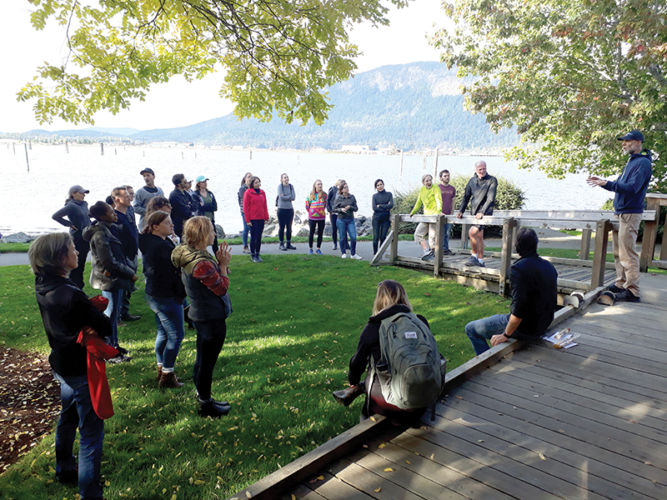In the Cowichan and Koksilah watersheds on eastern Vancouver Island, a quiet transformation is unfolding. Outside of the limelight and driven by community champions, over the past decade the Cowichan Watershed Board (CWB) has taken exceptional steps to change how water is managed and governed.
With perseverance, patience, and partnerships, the CWB is strengthening local capacity and influence, and building a foundational partnership with the Cowichan Valley Regional District (CVRD) and Cowichan Tribes that actively expresses “reconciliation in action.”
The Cowichan example is just one of many bright lights in British Columbia and beyond where watershed governance has shifted from aspiration to present-day reality, thanks to leadership from Indigenous nations, local governments, community groups, and local champions to drive change.
Watershed governance squarely confronts the pressing question: How can those who live and work in a watershed—with their different, and sometimes conflicting, priorities, perspectives, needs, and opinions—work together to share responsibility and keep water and surrounding lands healthy and resilient? It is about shifting away from a centralized, top-down approach to new forms of decision-making for water and land that:
- Adapt to local priorities and context.
- Respect and draw on Indigenous laws, authority, and knowledge.
- Embrace a “whole-of-watershed” approach, which means integration between different authorities to move beyond silos and link land and water.
- Are informed and driven by local capacity and expertise.
- Give those affected by decisions a say by building local “power.”
Systemic change of this nature is daunting, emergent, and often messy. No blueprint exists for exactly how to achieve governance transformation. Yet, through several years of research and direct work with communities, Crown governments at all levels, Indigenous nations, and watershed entities—we have identified tangible milestones for watershed partners to strengthen their role in decision-making to improve outcomes on the land and in the water.
The Stepping Stones Framework
The Stepping Stones Framework outlines seven steps towards building influence and momentum towards watershed governance. Meeting people where they are in their process, the Framework includes self-assessment questions for watershed groups and initiatives to identify their level of readiness, what their strengths are, and how they can move forward—whether they represent a local government, Indigenous nation, community group, or watershed entity.
At a glance, the seven steps are:
- Champions and Commitment. This first step involves building support within your organization or government for action on water and preparing for more intensive work down the road.
- Projects and Pooling Knowledge. This step entails getting out into the watershed via boots-on-the ground projects that enhance ecosystem health and knowledge and foster positive early partnerships and relationships with other governments and groups as a basis for longer-term collaboration.
- Shared Visioning and Setting Priorities. This step involves co-creating a shared vision for the watershed and honing in on solutions needed to protect and wisely share water resources.
- Use Local Resources and Authorities. This phase involves Indigenous governments, local governments, and non-profit organizations using their existing authority, mandates, and resources to support implementation of watershed goals and priorities.
- Formalize an Advising Role and Exert Influence. At this step, with demonstrated expertise, a track-record of substantive achievements, applied local science and information, and proven credibility, collaborative groups can seek to formalize their role in advising decision-making and shaping the outcomes of policy and regulatory development by formal authorities such as Crown governments.
- Collaborative Watershed Planning. This step involves taking a holistic, watershed-wide planning approach for dealing with interrelated land and water pressures, and addressing cumulative impacts. It entails identifying which legal and non-legal tools, across all levels of government, are needed to achieve goals and tangible improvements in ecological health, and community and economic resilience. Planning can be labour- and process-intensive.
- Shared Authorities. This step ventures into often new territory by going beyond just an advisory role. At this stage, decisions are made by watershed entities that are formally mandated, local, and co-governed. Decisions are grounded in Indigenous or Crown laws, or both. Innovation is the name of the game here!
Of course, things are never as neat as seven simple steps, and the stepping stones are not linear. They can be pursued in tandem, repeated, or sustained. Projects like monitoring, for instance, are generally ongoing throughout the planning and more advanced shared decision-making phases.
And any stone is a good place to be. For some groups like small community organizations, doing effective “gumboots-on-the-ground” projects can be the most appropriate niche to fill to contribute to overall watershed health and resilience. No one-size-fits-all approach exists. The process looks different in different watersheds and must be adapted to local contexts, priorities, histories and cultures.

Stepping Stones in action in the Cowichan
Returning to Vancouver Island’s Cowichan watershed, how have the stepping stones been implemented or explored?
Crisis brings opportunity, and the catalyst for action in the Cowichan was the turn-of-the-century drought. The situation was ugly: Salmon had to be driven upstream in trucks because flows dropped so low. Fears ran high that the pulpmill would have to shut down (a major employer in the area) and that the Indigenous food fishery would be lost. From acrimony and tension, local champions realized a new path forward, especially in light of fact that issues were not going to get any easier with a
climate in chaos.
The first step after this crisis was to develop a Cowichan Basin Water Management Plan. This is not a legally binding plan, but sets out a shared vision, goals, objectives, and actions. Although watershed planning is generally seen a later stage activity, in the Cowichan, planning provided the kickstart to build relationships and identify further projects and partnerships in the watershed.
In the case of the Cowichan, a key early insight was that making plans stick you need attention to governance. Too many plans sit on the shelf because we fail to figure out who will oversee implementation. The Cowichan Watershed Board (CWB) was formed in 2010 (under the wise leadership of real local champions) to provide direction for sustainable watershed management and to implement the Plan. From the outset, Cowichan Tribes and the Cowichan Valley Regional District (CVRD) have co-chaired the Board, each exerting their respective authority. Through this model, Cowichan Tribes and the CVRD are developing strong partnerships and demonstrating a deep commitment to moving down the path of reconciliation—together.
Although it does not have formal (or regulatory) authority, the CWB is established as a trusted, legitimate leader on watershed issues, with several spheres of influence. Through an array of major watershed monitoring/restoration projects, the Board builds deep understanding of watershed health and dynamics. It generates linkages between different agencies often operating in isolation, and provides a key bridge between interests in complex water challenges (including for example, water management at the Cowichan Lake weir). Through partnerships, the Board generates significant funding for watershed governance and exerts influence on citizens, communities, and decisions like zoning and local government priorities in the region.
Today, guided by an interim letter of agreement signed in February 2020, Cowichan Tribes and the British Columbia Ministry of Forests, Lands, Natural Resource Operations and Rural Development are working together to jointly scope the benefits of a Water Sustainability Plan (under the provincial Water Sustainability Act) for the Koksilah Watershed. This bears watching as a space for further government-to-government planning innovation where a Water Sustainability Plan is envisioned as a longer-term goal to address local drought and land-water stresses.
The Cowichan story illustrates perfectly that while there are clear milestones, the process of watershed governance is not linear. And, like all relationships, governance evolves, changes, and matures over time.
This article was written by Rosie Simms and Oliver M. Brandes for the November/December 2020 issue of Water Canada. Rosie Simms is a researcher and project manager at the POLIS Water Sustainability Project. Oliver M. Brandes is the associate director at the University of Victoria’s Centre for Global Studies and co-director of the POLIS Project on Ecological Governance.











